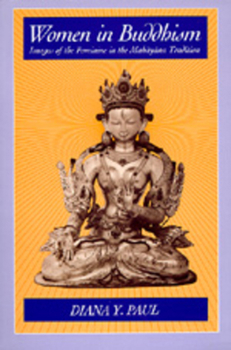Women in Buddhism: Images of the Feminine in the Mahayana Tradition
Select Format
Select Condition 
Book Overview
"In seeking to explore the interrelationships between, and mutual influence of, varieties of sexual stereotypes and religious views of the Mahayana Buddhist tradition, Women in Buddhism succeeds in drawing our attention to matters of philosophical importance. Paul examines the 'image' of women which arise in a number of Buddhist texts associated with Mahayana and finds that, while ideally the tradition purports to be egalitarian, in actual...
Format:Paperback
Language:English
ISBN:0520054288
ISBN13:9780520054288
Release Date:April 1985
Publisher:University of California Press
Length:333 Pages
Weight:1.00 lbs.
Dimensions:0.9" x 5.5" x 8.2"
Related Subjects
Asia Buddhism History Religion Religion & Spirituality Social Science Social Sciences Women in HistoryCustomer Reviews
2 ratings
4.5 stars--Great Commentary but mostly ancient texts
Published by Thriftbooks.com User , 19 years ago
This is, p. xii, "an attempt to document a range of problems concerning the depiction of women & her feminine nature in Mahayana literature." It covers the 2nd to 6th c. CE, following Horner's "Women Under Primitive Buddhism" which addressed 1st c. CE Theravada Buddhism. Thus, it has become a classic work. It presents texts in 3 Parts "progressing from the most negative images of the feminine to the most positive." Within each Part, each chapter has a chapter introduction, excerpt introductions, & selected excerpts, 19 in all (16 are sutras, 9 are translated for the 1st time). Tantric Buddhism is excluded but mentioned a few times. The best parts IMHO are Paul's general introduction & conclusion. She gives pithy, generic, but undocumented comments on Mahayana sutras, providing context for the work: pp. xxii-xxiv: "The sutras developed over 100's of years in different regions & by different authors...the sutras are not dated & the authorship is unknown...some of the sutras were originally folktales or myths...they developed over a long time, with continuous emendations & accretions...many of the texts no doubt have incorporated what were originally non-Buddhist ideas & attitudes...textual materials may represent only orthodoxy & not the common tradition of lay Buddhist practitioners"--yet their acceptance as scripture indicates their acceptance in principle. Her main thesis is that, p. 309: "the tension between sexual prejudice & religious ideals was reflected throughout Buddhist literature." While, p. 3: "Buddhist literature implies that woman is biologically determined to be sexually uncontrollable...the `eternal feminine' as temptress & seductress is a common element in religious thought," antithetically, p. 284: "tension between the egalitarian view toward both sexes based upon the teaching of Emptiness & the discriminatory view toward women was readily apparent." Thus, p. 250: "Mahayana Buddhism gradually acknowledged the importance of the feminine." She explains the several possible reasons for early misogyny (ancient Indian cultural norms, social needs, resource competition), & hints at psychological projection by monks dependent upon women's alms while exhorted to avoid contact & desire for them. In addition, pp. 284-5, "the notion of sexual transformation as a latent form of discrimination" depicts female Bodhisattvas changing to males--despite their assertions of emptiness & equality, "All of the Buddhas in their various Buddha lands are depicted in Mahayana sutra literature as either male or androgynous...[but] when one views the ideal spiritual state as desireless, the notion of Buddhahood must be viewed as sexless, illustrating the emptiness of all distinctions which result from desire ...Celestial Bodhisattvas such as Kuan-Yin also are viewed as asexual, magically transforming to suit the needs of the devotee." Similarly, Buddhism seems to have transformed to suit the needs of evolving humanit
An excellent collection and analysis of ancient texts.
Published by Thriftbooks.com User , 24 years ago
This is an interesting commentary and translation of several key pieces of early Buddhist literature on women and their various roles in society. Paul organizes the book around several key types, such as "Temptress", "Mother", and "Nun". Each translation is preceeded by a very useful "introduction" which explains the context of the piece that follows as well as providing some interpretation. This book is not for those interested in exploring the lives of contemporary Buddhist women, but rather provides for those interested in such things, an interesting analysis of ancient texts that relate to women.






